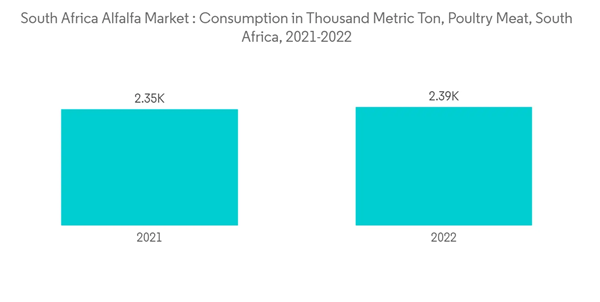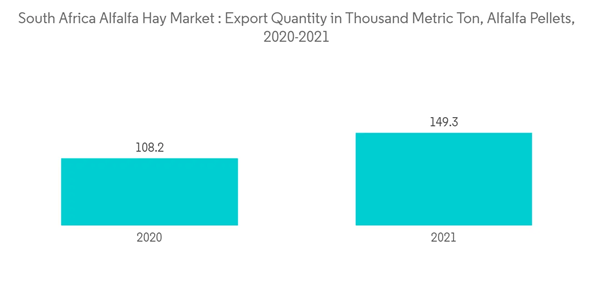The South Africa Alfalfa Hay Market size is estimated at USD 336.86 million in 2024, and is expected to reach USD 443.52 million by 2029, growing at a CAGR of 5.60% during the forecast period (2024-2029).
This product will be delivered within 2 business days.
Key Highlights
- Alfalfa hay is obtained from the alfalfa plant, which is commonly known as lucerne. Alfalfa hay has become critical to both dairy animal feed and poultry feed in recent years due to its crude protein content. Dependence on alfalfa hay for animal feed may continue to drive the South African alfalfa hay market over the forecast period. Further, the relatively dry and warm climate, good water quality through irrigation, and fertile soils in the Northern Cape are ideal for producing high-quality lucerne hay.
- Significant growth in the market can be witnessed in South Africa, mainly because of the changing production practices in the dairy industry. An increasing number of cows are being raised by modern dairy farmers, who prefer using imported hay and commercial feeds. The government is focusing on boosting domestic alfalfa hay production to meet this high demand from dairy farmers. According to various research studies, feeding alfalfa hay enhances the growth of animals and improves their milk productivity. Hence it is commonly included in the diets of lactating dairy cows as it is a rich source of protein and energy. It ferments quickly, has a wide mineral profile, and provides the fiber required for rumen health and butterfat synthesis in milk.
- South Africa has witnessed a shrinkage of grazing fields for animals. This is driving demand for forage crops (including alfalfa) to feed the livestock and meet all the nutrition requirements of the animals. The increased demand for forage crops positively impacts the area harvested for alfalfa in this region. The country appeared as a market leader as demand increased due to the worst drought in Africa. South Africa's alfalfa is exported globally because of its quality and grading. Over the long term, the increasing demand for quality feed will drive the market's growth.
South Africa Alfalfa Hay Market Trends
High Meat Consumption is Boosting Demand for Quality Hay
- Meat consumption is a major factor responsible for the growth of the South African alfalfa market. The quality of meat products primarily drives the meat market in the country. Meat is the desired source of protein in major parts of the country. The consumption of animal products such as milk, cheese, and meat is increasing across South Africa. This can be attributed to increasing health consciousness among consumers who are reducing their consumption of fatty and high-calorie foods and shifting to healthy dairy and meat products.
- The Organisation for Economic Co-operation and Development (OECD) reported that South Africa consumed 2,392 thousand metric tonnes more poultry meat in 2022 than it did the year before, or a rise, compared to the previous year. This increased interest in high-quality meat and dairy is aiding the alfalfa market in the country.
- Alfalfa is considered one of the finest products in the international market owing to a good grading system in place that was developed by the National Lucerne Trust (NLT). The high demand for quality dairy and meat products is increasing the demand for quality feed, which, in turn, is driving the market for alfalfa, as farmers are choosing good-quality forage for cattle to produce high-quality animal products.
- The driving force for the booming dairy industry is the consistent adoption of technology, which aids in managing larger herds of cows for scalable profit. This will likely drive the general market for forage seeds specifically used for feed, which, in turn, will drive the market for alfalfa.
- Additionally, the growing demand for meat and meat-based products, such as processed burgers and sausages, is anticipated to have a remarkable penetration across the food service sector, prominently in the quick service restaurant (QSR) segment. This is futher likely to aid the market during the forecast period.
Increased Global Demand for South African Alfalfa
- South Africa's alfalfa is known globally because of its quality and grading. According to the Comtrade data, South Africa exported 149.3 thousand metric tons of alfalfa pellets globally in 2021. Also, the South African lucerne is graded number 1, as certified by the National Lucerne Trust (NLT) under the National Lucerne Trust's new lucerne hay quality index (NLQI) used to grade the quality of the lucerne depending on the amount of protein and fiber.
- The major importers of South African alfalfa pellets are Saudi Arabia, the United Arab Emirates, Botswana, Qatar, and Namibia. South Africa exports most of its alfalfa pellets to Namibia. The demand for alfalfa hay is increasing significantly in Namibia due to changing production practices in the Namibian dairy industry.
- Modern dairy farmers in Namibia and worldwide are raising an increasing number of dairy cows, and they prefer using South African alfalfa in cattle feed. Thus, the rising global demand for quality and protein-rich alfalfa hay from the country is expected to benefit the South African market in the near future.
South Africa Alfalfa Hay Industry Overview
The South African alfalfa hay market is extremely fragmented, with some key players including AL Dahra ACX Inc., Alphaalfa (Pty) Ltd, General Overseas Traders Pty Ltd., Agritrade Global(Pty) Ltd, and Grains For Africa (Pty) Ltd. Increased livestock farming has fueled the demand for alfalfa hay suitable for different types of animals. This has prompted companies to invest in developing new products to capture larger market shares. Additionally, companies are broadening their product portfolio to meet the demand for alfalfa hay for different species of animals. Furthermore, as the global demand for quality lucerne is rising, the major players in the country are at present investing in technology to ensure quality and cost-effectiveness.Additional Benefits:
- The market estimate (ME) sheet in Excel format
- 3 months of analyst support
This product will be delivered within 2 business days.
Table of Contents
1 INTRODUCTION
4 MARKET DYNAMICS
5 MARKET SEGMENTATION
6 COMPETITIVE LANDSCAPE
Companies Mentioned (Partial List)
A selection of companies mentioned in this report includes, but is not limited to:
- Alphaalfa (Pty) Ltd.
- Al Dahra ACX Inc.Â
- Agritrade Global(Pty) Ltd.
- Hulmac Trading SA Pty Ltd.
- General Overseas Traders Pty Ltd
- Grains For Africa (Pty) Ltd.
- Cherangani Trade And Invest 102 (Pty) Ltd. (Multi Feeds
- RCL Foods Consumer (Pty) Ltd. (Epol Equine)
Methodology

LOADING...










